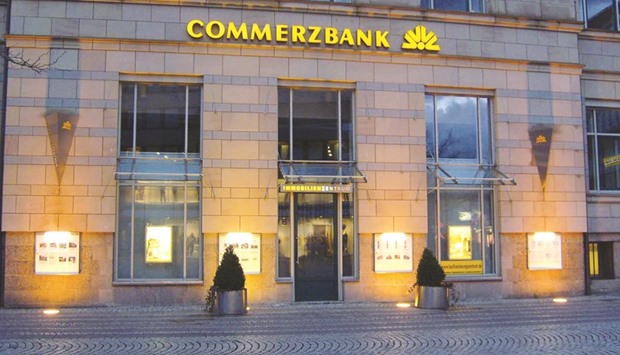The message couldn’t be simpler on the brochures dispatched to private households in Frankfurt this week: There’s only one “deutsche” bank standing by customers in Germany. Except Deutsche Bank is not the bank intended.
Commerzbank, Germany’s No 2 lender, is resorting to tongue-in-cheek marketing methods to lure customers in areas Deutsche Bank is exiting. The brochures show a handyman removing the last letter of a Deutsche Bank logo hanging on a wall.
The wordplay is the centrepiece of a campaign begun on September 4, before Deutsche Bank revealed that the US Justice Department is seeking $14bn to settle a probe into residential mortgage-backed securities — a sum the bank said it has “no intention of paying.” It’s especially poignant at a time when Germany’s largest lender is teetering amid investor doubts that it has the reserves to cover its legal bills. It also demonstrates just how ferocious competition for bank customers in Germany has become in a market wracked by sinking margins, low interest rates and punishing regulation.
“Commerzbank has been quite successful in reaching their previous new customer target in the past and they have done a lot of marketing to get there,” said Neil Smith, an analyst at Bankhaus Lampe.
“All these new clients they want to attract need a place to go. The real challenge is not the number of customers; it’s the revenue they can get out of them and business done out of a branch office could indeed be a bit more of the complex type with richer margins.”
Unlike Deutsche Bank, which announced plans in June to reduce its branches to 535 from 723 next year, Commerzbank says its branch network is key to its strategy to add two million new clients by 2020, double its previous target. Chief executive officer Martin Zielke, 53, is keeping the bank’s approximately 1,000 branches in Germany. At the same time, he’s eliminating 9,600 jobs as Commerzbank consolidates to focus on private and small business customers as well as corporate clients.
The brochures are part of a “tactical marketing campaign aimed at winning clients in regions where competitors close branches,” Commerzbank spokeswoman Margarita Thiel said. “Closing branches means losing customers and our goal is to win customers, no matter where they come from.”
Zielke’s strategy runs counter to Commerzbank’s peers, who are cutting back as bank customers increasingly conduct their business online. HVB Group, UniCredit’s German unit, had closed 234 of its 575 branch offices by the end of last year to reduce expenses for personnel and rent. It’s also an attempt to take business away from savings banks, which operate a deeper branch network than commercial competitors.
“Sticking to a strong number of branches is certainly a bold move by Commerzbank,” said Philipp Haessler, an analyst at Equinet. “It may indeed be an opportunity to attract new customers who now have to make a longer trip to visit their traditional bank because the branch around the corner has been closed.”
Although Germany is home to the largest number of systemically important banks in Europe, it’s also the country with the highest number of small lenders, almost half of the euro-area total, according to a report by the Bruegel think tank in Brussels.
Germany’s three-pillar system of commercial institutions, savings banks and cooperative lenders means it’s one of the most fragmented in Europe — and one of the least profitable. The country’s 403 savings banks operate 14,450 branches across the country, while 1,021 cooperative lenders, the so-called Volksbanken und Raiffeisenbanken, run 12,260 outlets. The competition has only deepened the pain of negative interest rates and stiffer regulation.
For the private and small business customer segment, “the most important factors are physical proximity and confident personal advice,” Zielke said at a press conference in Frankfurt last week. Meeting its target of one million new clients by the end of this year will give Commerzbank a market share of about 10% in Germany, he said at the time.
“We’re glad to see that many of our competitors are taking the opposite approach,” Zielke said.
“This increases our chances to gain market share, since in the next few years between 20mn and 30mn customers in Germany will lose their local branch due to closures.”
Zielke’s plan is not without risks, Equinet’s Haessler said.
“To make Commerzbank’s strategy to hold onto branches work, they will need to make sure that these operate in a lean way with opening hours that cater well to today’s requirements where especially the younger generation doesn’t feel a great need to walk into a bank anymore,” the analyst said.

Commerzbank, Germany’s No 2 lender, is resorting to tongue-in-cheek marketing methods to lure customers in areas Deutsche Bank is exiting. The brochures show a handyman removing the last letter of a Deutsche Bank logo hanging on a wall.


